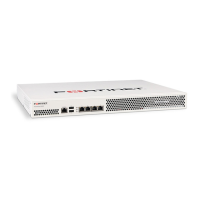Fortinet Technologies Inc. Page 29 FortiVoice 200D/200D-T v2.0 MR1 CLI Reference
dialplan inbound
Use this command to configure dial plans for incoming calls to the FortiVoice unit.
When the FortiVoice unit receives a call, the call is processed according to the inbound dial
plan. To process the call, the FortiVoice unit selects the dial plan rule that best matches the
dialed number and processes the call using the settings in the dial plan rule. For example, if
your main line is 123-4567, you can set a dial plan rule that sends all incoming calls dialing 123-
4567 to the auto attendant. Once the auto attendant is reached, the callers can follow the
instructions, for instance, to dial an extension.
Syntax
config dialplan inbound
edit <name>
config from-callerid
edit <No.>
set number-pattern <string>
config <dial-pattern>
set pattern <string>
set postfix <string>
set prefix <string>
set strip-digits <integer>
set call-handling {call-routing | dial-local -number | endpoint-
action}
set from-trunk <name>
set match-dialed-did <string>
set status {enable | disable}
end
Variable Description Default
<name> Enter a name for the inbound plan.
<No.> Enter a record number for the caller ID match.
number-pattern <string> Enter an incoming call’s display name string or the caller’
phone number string as the pattern.
Caller IDs under this pattern are subject to this inbound
plan.
For information on pattern-matching syntax and pattern-
matching examples, see “pbx number-management” on
page 57.
<endpoint-action> This action is available if endpoint-action is selected
for <endpoint-action>.
<No.> Enter a record number for the endpoint action.
action {auto-attendant |
dial-extension | dial-
operator | dial-voicemail |
hang-up | hang-up |
lookup-name-directory |
no-action | play-
announcement}
Select an action for the incoming calls under this plan.
For some actions, you need to enter the extension (such
as Go voicemail) or select a profile (such as Play
announcement).
no-action

